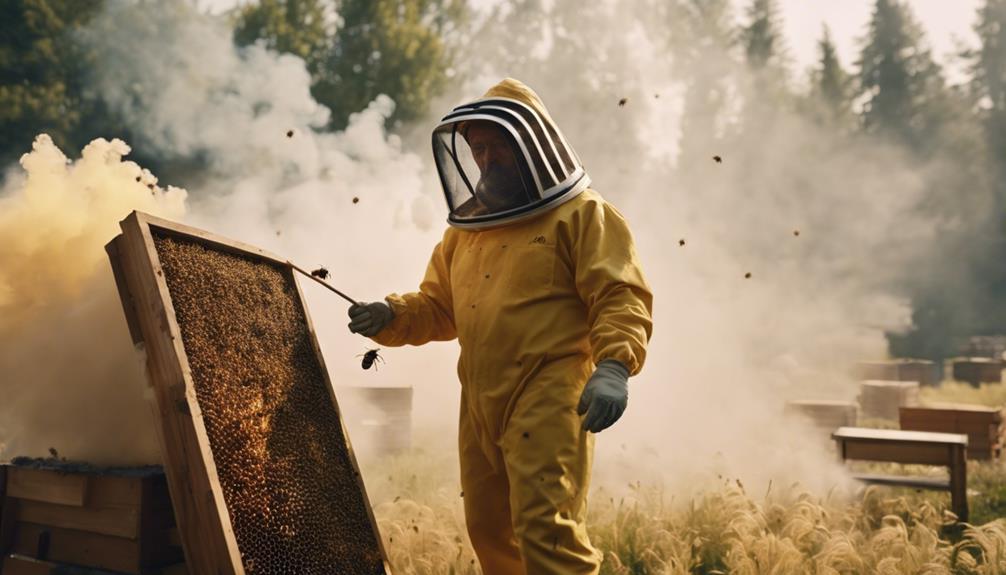Embarking on a city beekeeping journey can be a rewarding and environmentally impactful endeavor. As urban areas continue to expand, the role of urban beekeepers in supporting pollinator populations and fostering biodiversity becomes increasingly crucial.
However, the path to becoming a successful urban beekeeper is paved with considerations and preparations that are unique to city settings. From navigating local regulations to selecting the right bee species for your environment, each step requires careful planning and execution.
In this guide, we will explore the essential aspects of starting your city beekeeping journey, equipping you with the knowledge and tools necessary to establish and maintain a thriving urban bee colony.
Key Takeaways
- Prioritize diverse nectar sources and minimal pesticide exposure for urban beekeeping success.
- Understand local regulations, choose suitable honeybee species, and maintain colonies for thriving bee populations.
- Provide nutritious diets, manage pests, prevent swarming, and sustain a healthy bee environment.
- Maximize honey production, share locally produced honey, contribute to conservation efforts, and prioritize safety and education.
Beekeeping Benefits in Urban Areas
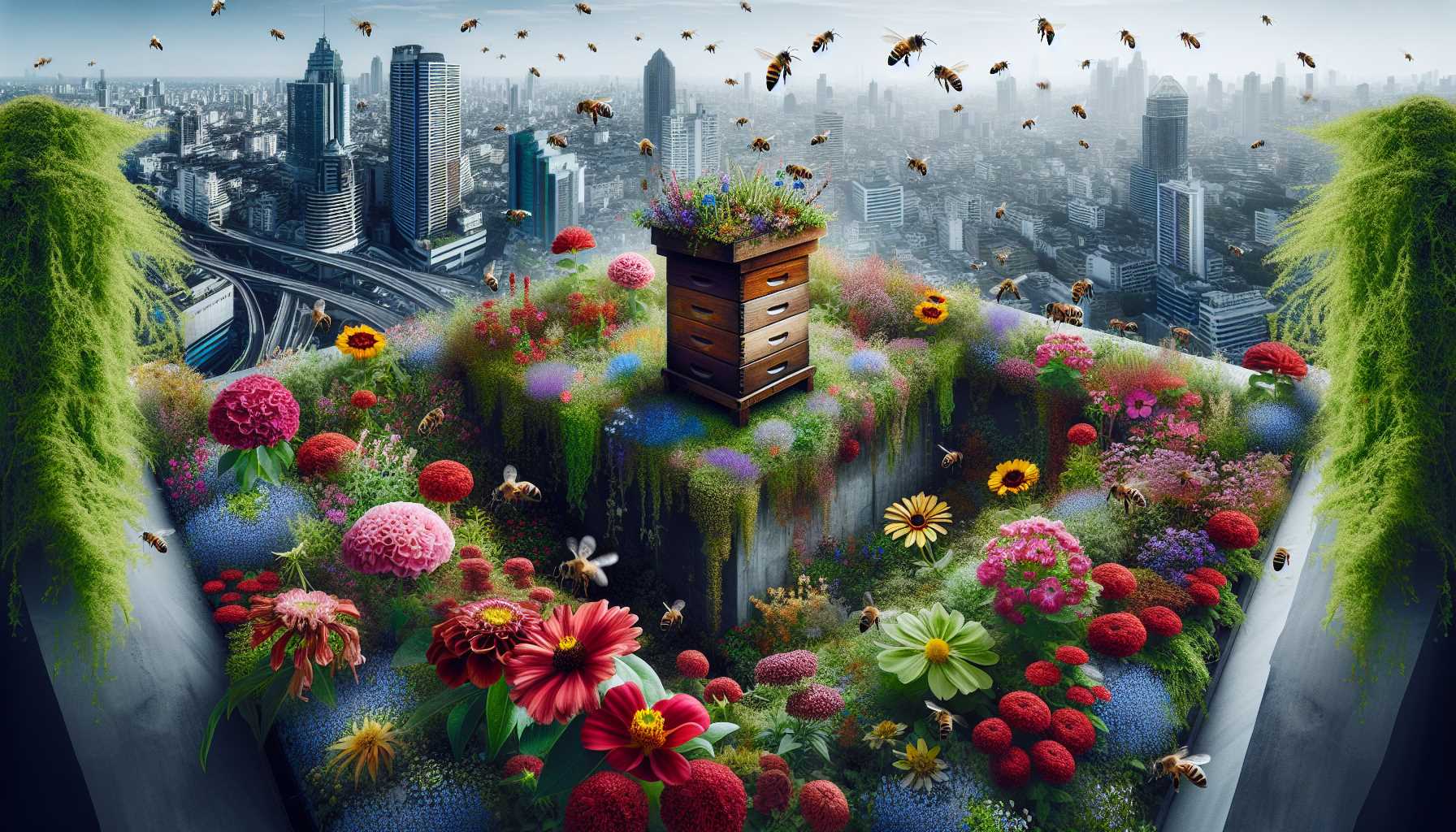
Urban beekeeping offers numerous advantages for both the environment and the community, making it a valuable practice in densely populated areas. By setting up rooftop hives in urban spaces, beekeepers contribute to sustainability efforts by providing bees with a safe haven to thrive amidst concrete jungles. These rooftop hives not only support the local bee population but also aid in pollination, benefiting nearby pollinator gardens and increasing biodiversity in urban landscapes.
Community involvement is another significant aspect of urban beekeeping. It fosters a sense of shared responsibility among city dwellers towards environmental conservation. Through educational programs, workshops, and public demonstrations, urban beekeepers can raise awareness about the importance of bees in our ecosystem. This engagement not only educates the public but also encourages them to participate actively in creating bee-friendly environments within their communities.
Choosing the Ideal Beehive Location

Selecting an optimal location for your beehive is a critical decision that directly impacts the well-being and productivity of your bee colony. When choosing the ideal beehive location in urban areas, consider setting up in rooftop gardens or community gardens for ample foraging opportunities and minimal disturbance. Rooftop gardens provide a peaceful environment with easy access to flowers, while community gardens foster a sense of community and support biodiversity.
For those with limited space, balcony apiaries or backyard apiaries are excellent options. Balcony apiaries can thrive in smaller areas, benefiting from the proximity to flowers and plants often found in urban settings. Backyard apiaries offer a more expansive space for your bees to forage and explore, enhancing their overall health and honey production.
Ultimately, the ideal beehive location should prioritize the well-being of your bees, ensuring they have access to diverse nectar sources, minimal exposure to pesticides, and protection from harsh weather conditions. By choosing a suitable location, you set the stage for a successful and thriving urban beekeeping journey.
Selecting the Right Honeybee Species
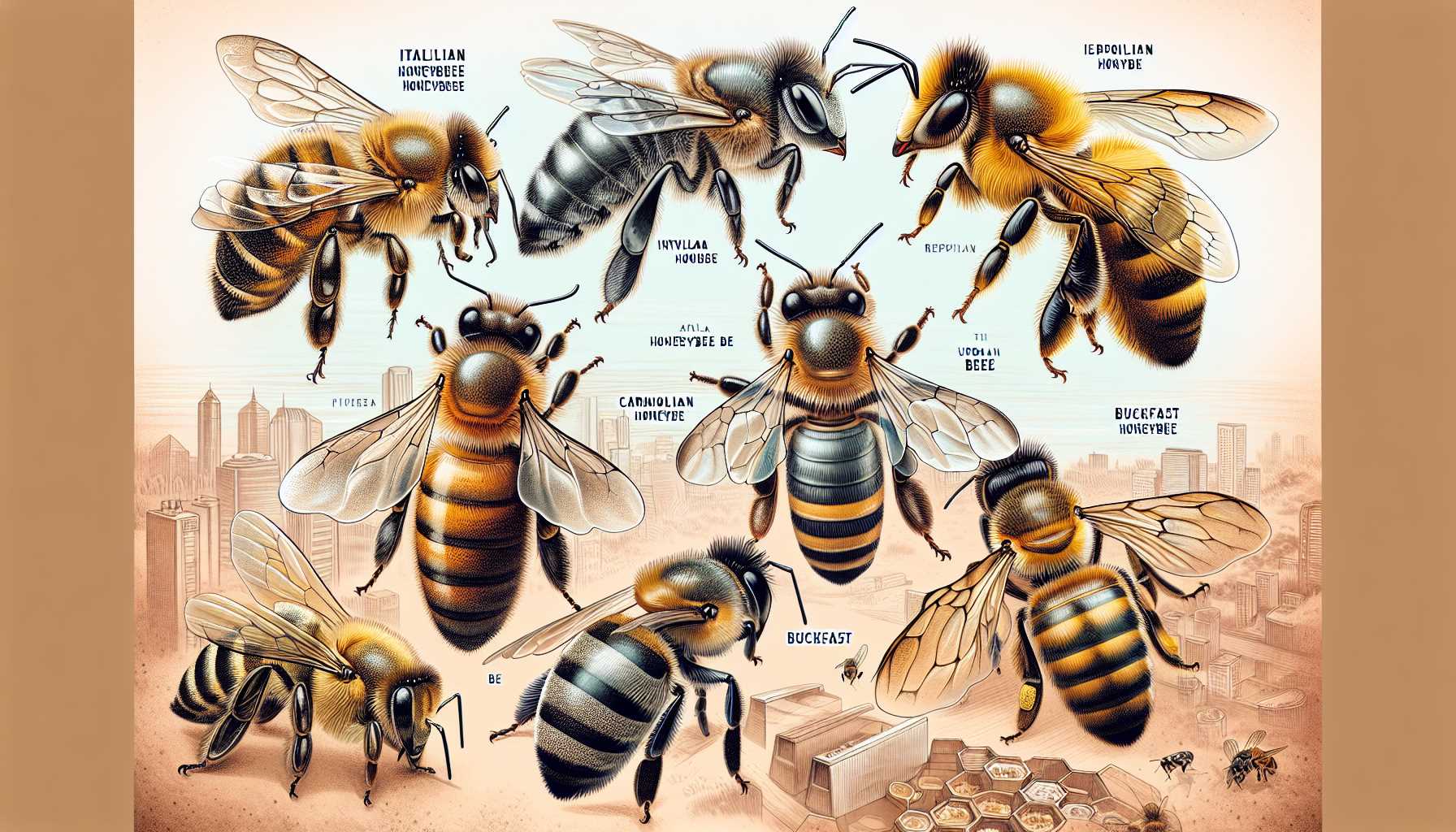
When considering the most suitable honeybee species for your urban beekeeping venture, it is essential to prioritize characteristics such as adaptability to local climates and foraging behaviors. Urban beekeeping offers a unique opportunity to contribute to bee species diversity and reap the urban pollination benefits they bring.
Here are four key points to consider when selecting the right honeybee species for your city apiary:
- Local Adaptability: Choose honeybee species that are well-suited to your specific urban environment, considering factors like temperature fluctuations and available forage.
- Docility: Opt for honeybee species known for their calm and gentle temperament, crucial for managing bees in close proximity to urban dwellings.
- Foraging Habits: Select honeybee species that exhibit strong foraging behaviors to ensure efficient pollination of urban gardens and green spaces.
- Disease Resistance: Prioritize honeybee species with genetic traits that convey resistance to common bee diseases prevalent in urban settings.
Understanding City Beekeeping Regulations

Understanding the city beekeeping regulations is essential for urban beekeepers to thrive. By knowing the local beekeeping laws, obtaining necessary permits, and following hive placement rules, beekeepers can ensure compliance and contribute positively to the community.
It is crucial to stay informed about the regulations to maintain a harmonious relationship between beekeepers, neighbors, and local authorities.
Know Local Beekeeping Laws
Navigating the intricate web of city beekeeping regulations is essential for urban beekeepers to ensure compliance and successful beekeeping operations within their local community. When diving into local beekeeping laws, keep these crucial points in mind:
- Beekeeping Zoning: Understand the specific zones where beekeeping is permitted in your city.
- Regulations Overview: Familiarize yourself with the rules and restrictions governing urban beekeeping.
- Urban Apiary Guidelines: Follow guidelines for maintaining beehives in urban settings.
- Community Interaction: Stay informed about how beekeeping practices can impact your neighbors and engage positively with your community.
Obtain Necessary Permits
To ensure a smooth and compliant urban beekeeping operation, obtaining necessary permits is a crucial step that requires a thorough understanding of city beekeeping regulations. Before starting your beekeeping journey in the city, familiarize yourself with the permit application process. Contact your local government authority to inquire about the specific permits required for keeping bees within city limits.
Be prepared to provide details about the number of hives you plan to maintain, the location of your hives, and any safety measures you will implement. Understanding urban beekeeping restrictions is also vital. Some cities have regulations regarding hive placement, bee flyways, and distance requirements from property lines or public areas.
Follow Hive Placement Rules
Proper hive placement is a fundamental aspect of urban beekeeping that directly correlates with city beekeeping regulations. When considering where to place your beehive in the city, keep these key factors in mind:
- Hive orientation, sunlight: Ensure your hive faces the right direction to make the most of the sunlight throughout the day.
- Nearby forage, flowers: Select a location with access to a variety of flowers and forage to provide your bees with diverse nectar sources.
- Distance from public spaces: Place your hive a safe distance from areas where people gather to avoid potential conflicts.
- Height above ground: Follow regulations regarding the height of your hive to ensure safety and accessibility for maintenance.
Essential Beekeeping Equipment and Tools

Equipped with the essential tools and gear, urban beekeepers are well-prepared to tend to their buzzing colonies with precision and care. Proper equipment maintenance is crucial for ensuring the longevity and efficiency of your beekeeping supplies. Regularly cleaning and inspecting tools such as hive tools, smokers, and bee brushes can prevent the spread of diseases and promote a healthy environment for your bees.
Protective gear is non-negotiable when it comes to beekeeping. A bee suit, veil, gloves, and sturdy boots are your first line of defense against stings and potential allergic reactions. Investing in high-quality protective gear will not only keep you safe but also boost your confidence as you work closely with your bees.
Additionally, having the right tools can make tasks like hive inspections, honey harvesting, and queen rearing much more manageable. Essential items include a smoker to calm the bees, a hive tool for prying apart frames, and a bee brush for gently moving bees without harming them.
Maintaining a Healthy Urban Bee Colony
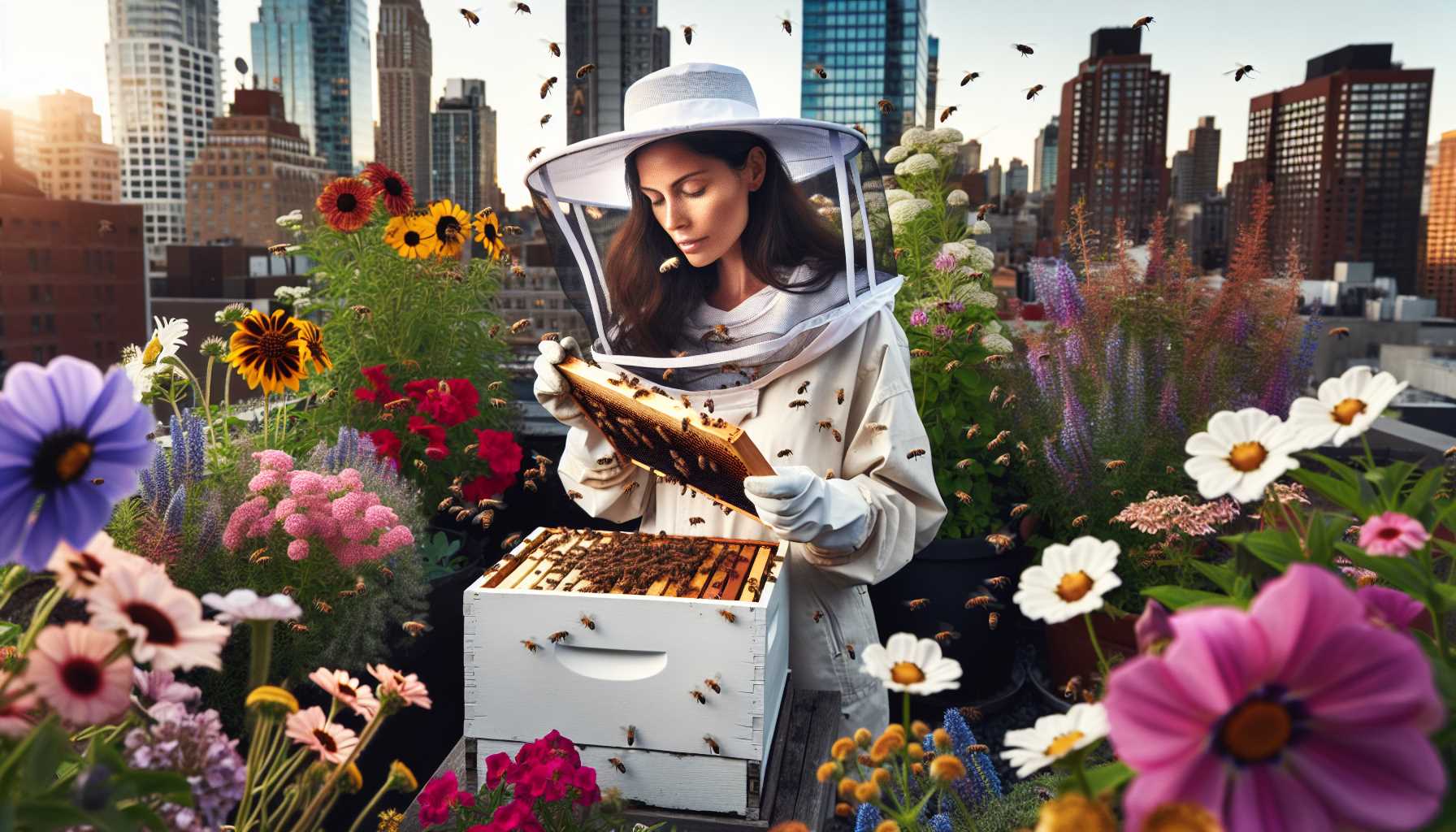
Maintaining a thriving urban bee colony requires diligent attention to the health and well-being of the buzzing inhabitants. Urban beekeepers must prioritize bee nutrition and effective pest management to ensure the colony’s vitality.
Swarm prevention strategies are crucial to prevent overcrowding and the potential loss of bees. Regular hive inspections help beekeepers monitor the overall health of the colony, identify any signs of disease or distress, and take necessary action promptly.
By staying proactive and observant, urban beekeepers can create a sustainable environment for their bees to thrive in the city landscape.
Key Points:
- Bee Nutrition: Provide a diverse and nutritious diet for your bees to support their overall health and immune system.
- Pest Management: Implement integrated pest management strategies to keep common pests at bay and protect your bee colony.
- Swarm Prevention: Monitor colony growth and provide adequate space to prevent swarming behavior.
- Hive Inspection: Regularly inspect your hives to check for signs of disease, pests, or other issues that may impact bee health.
Harvesting and Processing Urban Honey
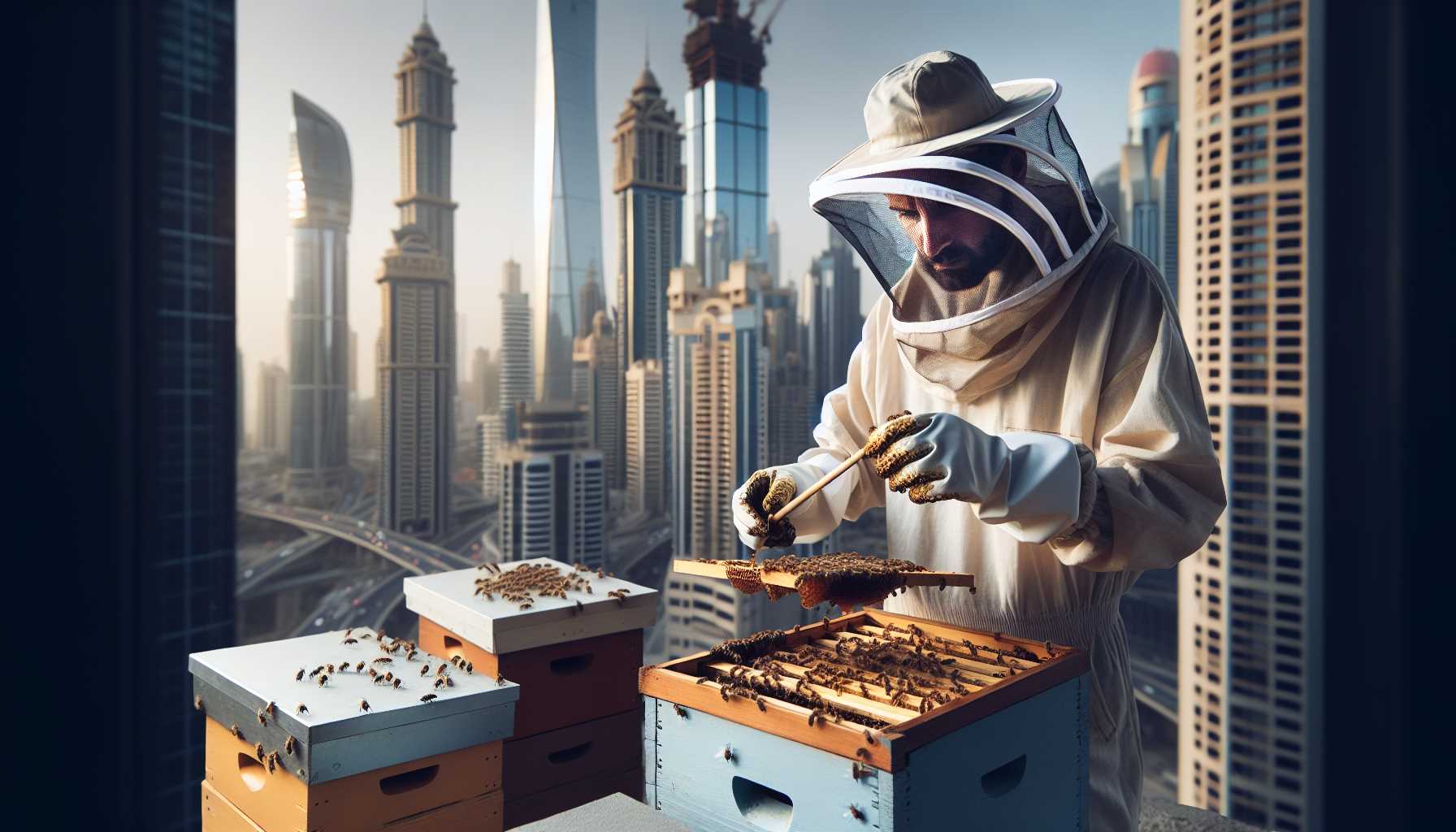
With a meticulous approach and a deep understanding of urban beekeeping practices, the process of harvesting and processing urban honey becomes a rewarding endeavor for beekeepers in bustling city landscapes. Honey extraction techniques are crucial in ensuring a successful harvest. Beekeepers must carefully remove the honey-filled frames from the hive, avoiding damage to the delicate honeycomb. Once the frames are collected, they can be uncapped using a hot knife or an uncapping fork to release the honey.
Effective beehive management plays a vital role in maximizing honey production. By providing a healthy environment for the bees to thrive, beekeepers can ensure a bountiful harvest. After the honey is extracted, beekeepers can explore urban honey markets to share their locally produced honey with the community. The honey bottling process involves filtering the honey to remove any impurities before bottling it up for sale. Urban beekeepers can take pride in providing their city with pure, delicious honey while contributing to the conservation of bees in urban environments.
Frequently Asked Questions
How Can I Protect My Urban Beehive From Vandalism or Theft?
Protecting your urban beehive from vandalism or theft demands vigilance akin to safeguarding a prized jewel. Implement robust security measures like surveillance cameras and consider installing decoy hives to deter potential intruders, ensuring the safety of your precious bees.
Are There Any Specific Challenges or Considerations for Urban Beekeepers When It Comes to Pest Management?
Integrated pest management strategies are crucial for urban beekeepers to combat challenges like limited foraging areas, pesticide exposure, and invasive pests. Regular monitoring, habitat diversification, and strategic use of treatments can help protect city hives.
How Can I Ensure My Urban Bees Have Access to a Diverse Range of Nectar Sources for Optimal Health?
To ensure optimal health for urban bees, prioritize nectar diversity by planting a variety of flowering plants. Embrace sustainability in urban beekeeping by creating a vibrant environment filled with different nectar sources, promoting bee health and vitality.
What Are Some Creative Ways to Educate My Community About the Importance of Urban Beekeeping?
Engaging your community about urban beekeeping involves innovative approaches like hosting community workshops and school presentations. By sharing knowledge on the importance of bees, you can inspire others to support bee populations for a sustainable future.
Can Urban Beekeepers Participate in Local Farmers Markets or Other Events to Sell Their Honey and Products?
Urban beekeepers can boost their honey sales by engaging in local farmers markets and community events. Marketing strategies like these not only increase revenue but also allow for valuable community outreach and education opportunities.

Roger Thomas is a seasoned beekeeper and hive architect with a deep-seated passion for sustainable living. His fascination with bees has shaped his professional career, giving him practical and theoretical expertise in bee behavior, colony health, and optimal hive conditions. Roger’s technical skills shine in his bespoke hive creations that cater to the specific needs of diverse bee species, while his sustainable practices promote environmental balance and the wellbeing of the bee population.
As he continues his journey in beekeeping, Roger has become a dedicated advocate for responsible practices and an insightful educator in his field. His posts aim to inspire new beekeepers, underline the importance of sustainability, and showcase the remarkable contribution bees make to our ecosystem. Roger invites you to join him as he delves into the world of bees and the rewarding, honey-sweet art of beekeeping.

